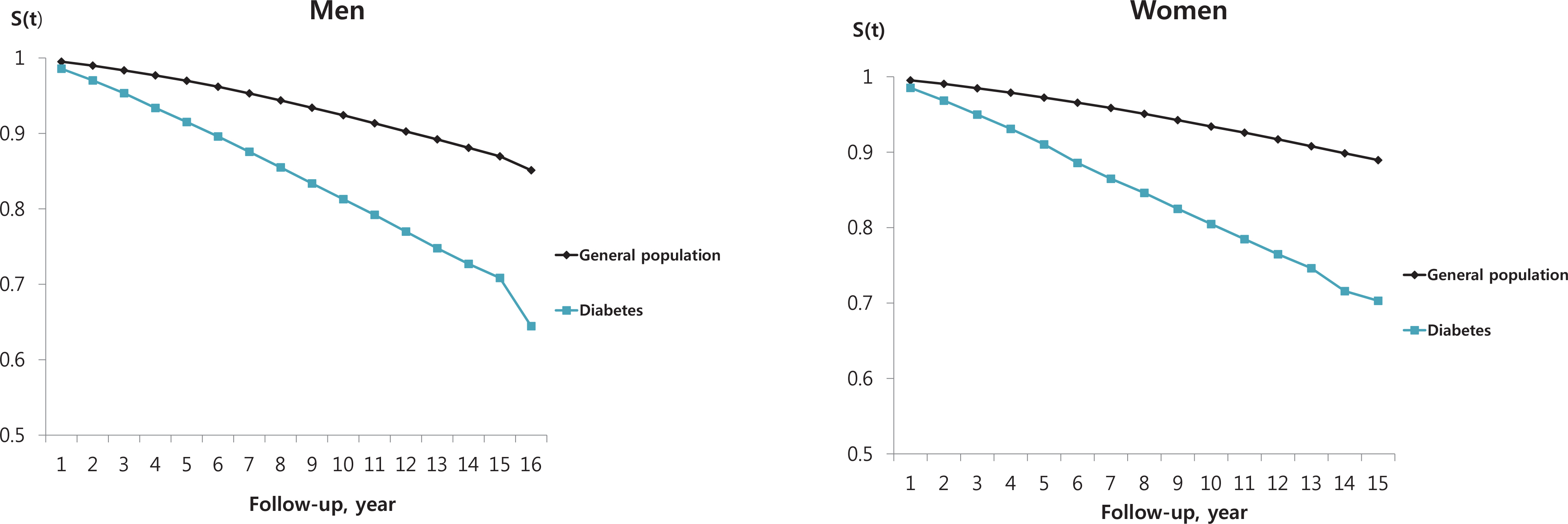J Korean Diabetes.
2015 Mar;16(1):6-10. 10.4093/jkd.2015.16.1.6.
Review on Cardiovascular Disease Prediction Model in Diabetes Patients
- Affiliations
-
- 1Department of Public Health, Graduate School, Yonsei University, Seoul, Korea.
- 2Institute for Health Promotion, Graduate School of Public Health, Yonsei University, Seoul, Korea. jsunha@yuhs.ac
- KMID: 2137277
- DOI: http://doi.org/10.4093/jkd.2015.16.1.6
Abstract
- The cardiovascular disease (CVD) risk prediction model has been developed based on information on CVD-free subjects, including age, hypertension, diabetes, cholesterol, and smoking status. A methodological review on whether the CVD risk prediction model is appropriate for diabetes patients is necessary. In general, the prediction model consists of three components-relative risk (RR), mean of risk factors, and survival rate. The prediction model would be useable if no differences in those components are found between the general population and diabetes patients. However, in our results, differences were found in the mean of risk factors and survival rate of CVD between the general population and diabetes patients, while no difference was found in RR. In other words, diabetes patients had a significantly increased mean of risk factors and decreased survival rates for CVD. Since the existing CVD risk prediction model for the general population is not applicable to diabetes patients, it is critical to develop a new model for them.
MeSH Terms
Figure
Reference
-
References
1. World Health Organization. Diabetes. Fact sheets N 312. Available from:. http://www.who.int/mediacentre/factsheets/fs312/en/. (accessed 2015 Jan 30).2. World Health Organization. Cardiovascular diseases (CVDs). Fact sheets N 317. Available from:. http://www.who.int/mediacentre/factsheets/fs317/en/. (accessed 2015 Jan 30).3. Kannel WB, McGee D, Gordon T. A general cardiovascular risk profile: the Framingham Study. Am J Cardiol. 1976; 38:46–51.
Article4. Wilson PW, D'Agostino RB, Levy D, Belanger AM, Silbershatz H, Kannel WB. Prediction of coronary heart disease using risk factor categories. Circulation. 1998; 97:1837–47.
Article5. D'Agostino RB Sr. Grundy S, Sullivan LM, Wilson P. CHD Risk Prediction Group. Validation of the Framingham coronary heart disease prediction scores: results of a multiple ethnic groups investigation. JAMA. 2001; 286:180–7.6. D'Agostino RB Sr. Vasan RS, Pencina MJ, Wolf PA, Cobain M, Massaro JM, Kannel WB. General cardiovascular risk profile for use in primary care: the Framingham Heart Study. Circulation. 2008; 117:743–53.7. Hense HW, Schulte H, Löwel H, Assmann G, Keil U. Framingham risk function overestimates risk of coronary heart disease in men and women from Germany–results from the MONICA Augsburg and the PROCAM cohorts. Eur Heart J. 2003; 24:937–45.
Article8. Liu J, Hong Y, D'Agostino RB Sr, Wu Z, Wang W, Sun J, Wilson PW, Kannel WB, Zhao D. Predictive value for the Chinese population of the Framingham CHD risk assessment tool compared with the Chinese Multi-Provincial Cohort Study. JAMA. 2004; 291:2591–9.
Article9. Stone NJ, Robinson JG, Lichtenstein AH, Bairey Merz CN, Blum CB, Eckel RH, Goldberg AC, Gordon D, Levy D, Lloyd-Jones DM, McBride P, Schwartz JS, Shero ST, Smith SC Jr, Watson K, Wilson PW, Eddleman KM, Jarrett NM, LaBresh K, Nevo L, Wnek J, Anderson JL, Halperin JL, Albert NM, Bozkurt B, Brindis RG, Curtis LH, DeMets D, Hochman JS, Kovacs RJ, Ohman EM, Pressler SJ, Sellke FW, Shen WK, Smith SC Jr, Tomaselli GF. American College of Cardiology/American Heart Association Task Force on Practice Guidelines. 2013 ACC/AHA guideline on the treatment of blood cholesterol to reduce atherosclerotic cardiovascular risk in adults: a report of the American College of Cardiology/American Heart Association Task Force on Practice Guidelines. Circulation. 2014; 129(25 Suppl 2):S1–45.10. Jee SH, Jang Y, Oh DJ, Oh BH, Lee SH, Park SW, Seung KB, Mok Y, Jung KJ, Kimm H, Yun YD, Baek SJ, Lee DC, Choi SH, Kim MJ, Sung J, Cho B, Kim ES, Yu BY, Lee TY, Kim JS, Lee YJ, Oh JK, Kim SH, Park JK, Koh SB, Park SB, Lee SY, Yoo CI, Kim MC, Kim HK, Park JS, Kim HC, Lee GJ, Woodward M. A coronary heart disease prediction model: the Korean Heart Study. BMJ Open. 2014; 4:e005025.
Article
- Full Text Links
- Actions
-
Cited
- CITED
-
- Close
- Share
- Similar articles
-
- Statistics and Deep Belief Network-Based Cardiovascular Risk Prediction
- Severe hypoglycemia as a preventable risk factor for cardiovascular disease in patients with type 2 diabetes mellitus
- Treatment Strategy for Diabetes with Cardiovascular Disease
- Recent Guideline for the Management of Dyslipidemia in Patients with Diabetes
- Development and Application of Chronic Disease Risk Prediction Models


